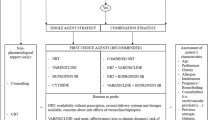Abstract
The inhalation of the vapors of chemical substances for the purpose of achieving an intoxicated state is currently quite popular within the adolescent population. However, this form of substance abuse often receives less attention than more well-known drugs, such as marijuana, cocaine, and alcohol. This paper is intended to be an introduction to the topic of inhalant abuse, including prevalence rates, the types of substances typically abused, their effects on the body, methods of inhalation, symptoms associated with this practice, the risks involved, and finally, the question of physical and psychological addiction.
Similar content being viewed by others
References
About inhalants. (1992). South Deerfield, MA: Channing L. Bete Co., Inc.
Atwater, E. (1992).Adolescence. Englewood Cliffs, NJ: Prentice Hall.
Blum, K. (1984).Handbook of abusable drugs. New York: Gardner Press Inc.
Chadwick, O., Anderson, H.R., Bland, J.M., & Ramsey, J. (1991).Solvent abuse: A population-based neuropsychological study (recent research in psychology). New York: Springer-Verlag.
Chaudron, D. (1978). Solvents—an industrial perspective. InSolvents, adhesives, & aerosols: Proceedings of a seminar held in Toronto in May, 1977, by the Ontario Ministry of Industry and Tourism in cooperation with the Addiction Research Foundation. Toronto, Canada: Addiction Research Foundation of Ontario, pp. 35–42.
Clinger, O.W., & Johnson, N.A. (1951). Purposeful inhalation of gasoline vapors.Psychiatric Quarterly, 25, 557–653.
Cohen, S. (1979). Inhalants and solvents. In G.M. Beschner & A. Friedman (Eds.),Youth Drug Abuse. Lexington, MA: Lexington Books.
Comstock, E.G., & Comstock, B.S. (1977). Medical evaluation of inhalant abusers. In C.W. Sharp & M.L. Brehm (Eds),Review of inhalants: Euphoria to dysfunction, NIDA Reasearch Monograph No. 15 (pp. 54). Washington, DC: U.S. Government Printing Office.
Corliss, L.M. (1965). A review of evidence on glue sniffing—a persistent problem.Journal of School Health, 35, 442–449.
Fernandez, J.A. (1978). Solvents—an industrial perspective.Solvents, adhesives, & aerosols: Proceedings of a seminar held in Toronto in May, 1977, by the Ontario Ministry of Industry and Tourism in cooperation with the Addiction Research Foundation. Toronto, Canada: Addiction Research Foundation of Ontario, pp. 35–42.
Fighting back: Helping young people kick the sniffing habit. (1991). Washington, DC: Chemical Specialties Manufacturers Association, Inc.
Gellman, V. (1968). Glue sniffing among Winnipeg school children.Canadian Medical Association Journal, 98, 411–413.
Gillman, M.A. (1986). Nitrous oxide: An opioid addictive agent.American Journal of Medicine, 87, 97–102.
Ghodse, H. (1989).Drugs and addictive behaviour: A guide to treatment. Oxford, England: Blackwell Scientific Publications.
Harris, J.R. (1974). A participant observer study: The everyday life of delinquent boys.Adolescence, 9(33), 31–48.
Inhalants (Mood-altering chemical series). (1986). Madison, WI: Wisconsin Clearinghouse.
Inhalants, pcp, designer drugs. (1987). New York: The American Council for Drug Education.
Inhalants: What you should know. (1992). St. Louis, MO: The National Federation of Parents for Drug Free Youth.
Joe, G.W., Garriott, J.C., & Simpson, D.D. (1991). Physical symptoms and psychological distress among inhalant users.Hispanic Journal of Behavioral Sciences, 13(3), 297–314.
Johnson, L.D., O'Malley, P.M., & Bachman, J.G. (1987).National trends in drug use and related factors among American high school students and young adults, 1975–1986 (DHHS Publication No. ADM 87-1535). Washington, DC: U.S. Government Printing Office.
Kerner, K. (1988). Current topics in inhalant abuse. In R.A. Crider, & B.A. Rouse (Eds),Epidemiology of inhalant abuse: An update, NIDA Research Monograph No. 85 (DHHS Publication No. ADM 88-1577; pp. 8–29). Rockville, MD: U.S. Department of Health and Human Services.
Macdonald, D.I. (1989).Drugs, drinking & adolescents (2nd ed). Chicago, IL: Year Book Medical Publishers, Inc.
Oetting, E.R., & Beauvais, F. (1990). Adolescent drug use: Findings of national and local surveys.Journal of Consulting and Clinical Psychology, 58, 385–394.
Pollard, T.G. (1990). Relative addiction potential of major centrally-active drugs and drug classes—inhalants and anesthetics. In B. Stimmel, C.K. Erickson, M.A. Javors, & W.W. Morgan (Eds),Addiction potential of abused drugs and drug classes (pp. 149–166). New York: The Haworth Press.
Press, E., & Done, A.K. (1967). Solvent sniffing. Physiological effects and community control measures for intoxication from the intentional inhalation of organic solvents.Pediatrics, 39, 451.
Robbins, E., Katz, S.B., & Stern, M. (1985). Identification and treatment of substance abuse problems in the emergency room. In A.I. Alterman (Ed),Substance abuse and psychopathology (pp. 239–288). New York: Plenum Press.
Simpson, D.D., & Barrett, M.E. (1991). A longitudinal study of inhalant use: Overview and discussion of findings.Hispanic Journal of Behavioral Sciences, 13(3), 341–355.
Sniffing: A parent's perspective. (1980). Phoenix, AZ: Do It Now Foundation.
U.S. Department of Health and Human Services. (1988).National household survey on drug abuse: Main findings 1988 (DHHS Publication No. ADM 90-1682). Washington, DC: U.S. Government Printing Office.
Watson, J.M. (1986).Solvent abuse: The adolescent epidemic? Great Britain: Billing & Sons Ltd.
Whitaker, B. (1987).The global connection: The crisis of drug addiction. Great Britain: Ebenezer Baylis & Son, Ltd.
Wilford, B.B. (1981).Drug abuse: A guide for the primary care physician. Chicago: American Medical Association.
Author information
Authors and Affiliations
Rights and permissions
About this article
Cite this article
Gorny, S.W. Inhalant abuse as an adolescent drug problem: An overview. Child Youth Care Forum 23, 161–175 (1994). https://doi.org/10.1007/BF02209226
Issue Date:
DOI: https://doi.org/10.1007/BF02209226




